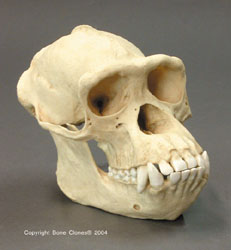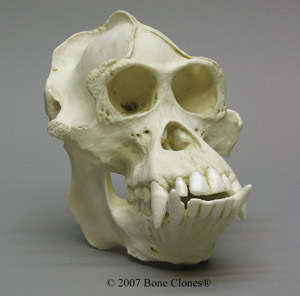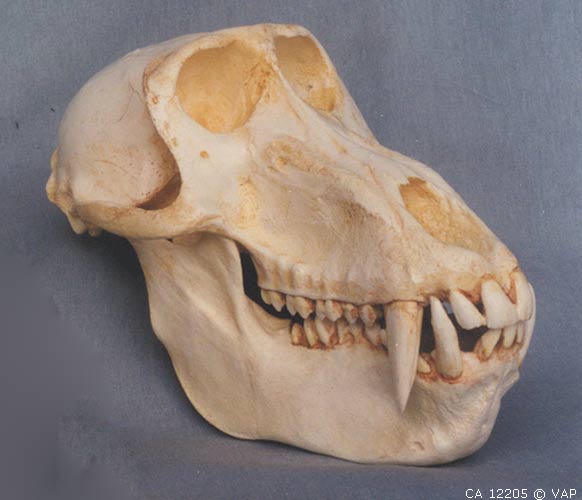
May 12, 2009
Above is the mysterious primate skull found at a North Dallas, Texas, construction site.
Compared to…

Bone Clones® Chimpanzee Skull
Pan troglodytes

Bone Clones® Borneo Orangutan Skull (Male)
Pongo pygmaeus

Bone Clones® Mandrill Baboon Skull (Male)
Mandrillus sphinx

Hamadryas Baboon Skull Cast (Male)
Papio hamadryas neumanii

Gelada Baboon Skull Cast (Sub-Adult)
Theropithecus gelada

Chacma Baboon Skull (Male)
Papio ursinus
What could it be?
Experts will determine the age of this primate skull found at a construction site.
“We all know it’s a primate,” said David Evans, 25, of Alvarado. “We just don’t know which kind.”
The skull was buried about five feet underground, he said, in muck. It’s six inches from front to back and two inches wide.
Most of the teeth, including one-inch canines, are intact.
Evans said the skull was discovered (a couple weeks ago) at the St. Alcuin Montessori School near Churchill Way and Preston Road.
A noted anthropologist for the Tarrant County Medical Examiner’s office, Dr. Dana Austin, viewed photographs of the skull and said it was definitely an “old-world primate,” possibly a monkey or chimp.
She said it was impossible to determine from the photos the age of the skull.
Evans, who talked to other experts, said he believes it may be a baboon.
“From everybody at UTA and everybody I’ve been talking to, (it’s) possibly a baboon,” he said. “But how it got to 635, right there at Churchill and Preston, I have no idea.”
Evans and other workers also found a small bone nearby, apparently from the same animal.
“It appears to be part of a femur or hip,” he said.
Evans plans to sell the skull if someone offers him a good price, but also may keep it as a conversation piece.
“If somebody comes over, that’s an hour right there,” he said laughing.
Source: “It’s a Skull, But What Kind? Workers unearth unusual skull in North Dallas,” by Scott Gordon.
In Texas, in the 1980s, a band of baboons was supposedly sighted along the Trinity River.
Mysterious America (1983, 2001, 2006) by Loren Coleman.
A free-roaming group of Japanese macaques (Macaca fuscata) was brought to Dilley, Texas, in 1972 to save it from destruction in Kyoto, Japan, where the animals are regarded as a nuisance; in 1980 the monkeys became the property of the South Texas Primate Observatory and were confined for behavioral research at a ranch there. But in the late 1980s, their enclosure fell into disrepair and several escaped. The monkeys have roamed the south Texas brush ever since, their population swelling to more than 600 by 1995.
Mysterious Creatures: A Guide to Cryptozoology (2002) by George M. Eberhart.
Consider a contribution today, and merely click to…
Thank you
About Loren Coleman
Loren Coleman is one of the world’s leading cryptozoologists, some say “the” leading living cryptozoologist. Certainly, he is acknowledged as the current living American researcher and writer who has most popularized cryptozoology in the late 20th and early 21st centuries.
Starting his fieldwork and investigations in 1960, after traveling and trekking extensively in pursuit of cryptozoological mysteries, Coleman began writing to share his experiences in 1969. An honorary member of Ivan T. Sanderson’s Society for the Investigation of the Unexplained in the 1970s, Coleman has been bestowed with similar honorary memberships of the North Idaho College Cryptozoology Club in 1983, and in subsequent years, that of the British Columbia Scientific Cryptozoology Club, CryptoSafari International, and other international organizations. He was also a Life Member and Benefactor of the International Society of Cryptozoology (now-defunct).
Loren Coleman’s daily blog, as a member of the Cryptomundo Team, served as an ongoing avenue of communication for the ever-growing body of cryptozoo news from 2005 through 2013. He returned as an infrequent contributor beginning Halloween week of 2015.
Coleman is the founder in 2003, and current director of the International Cryptozoology Museum in Portland, Maine.
Filed under Artifacts, Breaking News, Cryptotourism, CryptoZoo News, Evidence